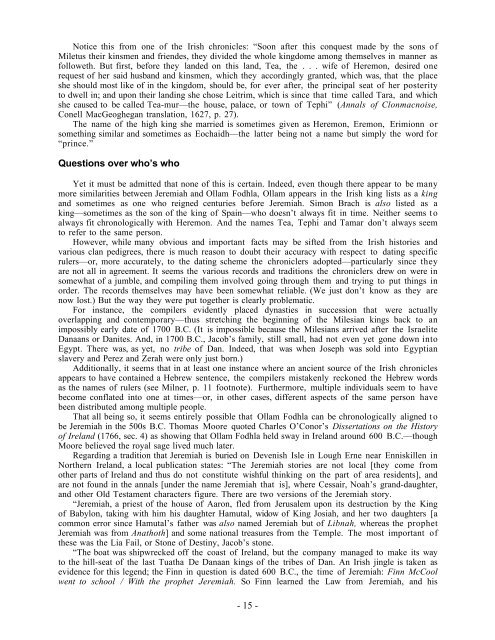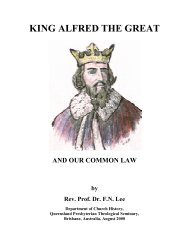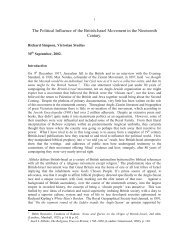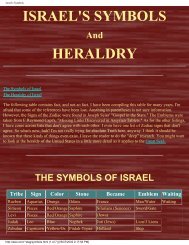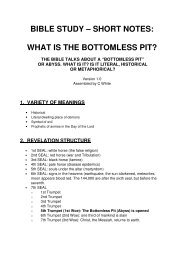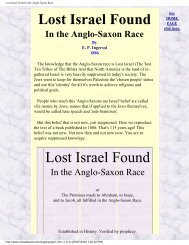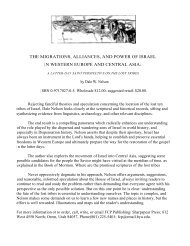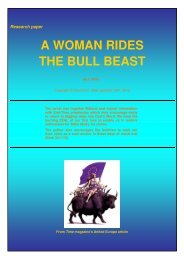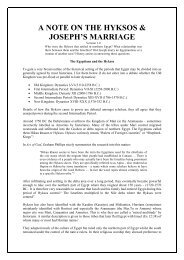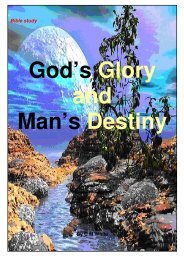The Throne of Britain: Its Biblical Origin and Future - Origin of Nations
The Throne of Britain: Its Biblical Origin and Future - Origin of Nations
The Throne of Britain: Its Biblical Origin and Future - Origin of Nations
Create successful ePaper yourself
Turn your PDF publications into a flip-book with our unique Google optimized e-Paper software.
Notice this from one <strong>of</strong> the Irish chronicles: “Soon after this conquest made by the sons <strong>of</strong><br />
Miletus their kinsmen <strong>and</strong> friendes, they divided the whole kingdome among themselves in manner as<br />
followeth. But first, before they l<strong>and</strong>ed on this l<strong>and</strong>, Tea, the . . . wife <strong>of</strong> Heremon, desired one<br />
request <strong>of</strong> her said husb<strong>and</strong> <strong>and</strong> kinsmen, which they accordingly granted, which was, that the place<br />
she should most like <strong>of</strong> in the kingdom, should be, for ever after, the principal seat <strong>of</strong> her posterity<br />
to dwell in; <strong>and</strong> upon their l<strong>and</strong>ing she chose Leitrim, which is since that time called Tara, <strong>and</strong> which<br />
she caused to be called Tea-mur—the house, palace, or town <strong>of</strong> Tephi” (Annals <strong>of</strong> Clonmacnoise,<br />
Conell MacGeoghegan translation, 1627, p. 27).<br />
<strong>The</strong> name <strong>of</strong> the high king she married is sometimes given as Heremon, Eremon, Erimionn or<br />
something similar <strong>and</strong> sometimes as Eochaidh—the latter being not a name but simply the word for<br />
“prince.”<br />
Questions over who’s who<br />
Yet it must be admitted that none <strong>of</strong> this is certain. Indeed, even though there appear to be many<br />
more similarities between Jeremiah <strong>and</strong> Ollam Fodhla, Ollam appears in the Irish king lists as a king<br />
<strong>and</strong> sometimes as one who reigned centuries before Jeremiah. Simon Brach is also listed as a<br />
king—sometimes as the son <strong>of</strong> the king <strong>of</strong> Spain—who doesn’t always fit in time. Neither seems t o<br />
always fit chronologically with Heremon. And the names Tea, Tephi <strong>and</strong> Tamar don’t always seem<br />
to refer to the same person.<br />
However, while many obvious <strong>and</strong> important facts may be sifted from the Irish histories <strong>and</strong><br />
various clan pedigrees, there is much reason to doubt their accuracy with respect to dating specific<br />
rulers—or, more accurately, to the dating scheme the chroniclers adopted—particularly since they<br />
are not all in agreement. It seems the various records <strong>and</strong> traditions the chroniclers drew on were in<br />
somewhat <strong>of</strong> a jumble, <strong>and</strong> compiling them involved going through them <strong>and</strong> trying to put things in<br />
order. <strong>The</strong> records themselves may have been somewhat reliable. (We just don’t know as they are<br />
now lost.) But the way they were put together is clearly problematic.<br />
For instance, the compilers evidently placed dynasties in succession that were actually<br />
overlapping <strong>and</strong> contemporary—thus stretching the beginning <strong>of</strong> the Milesian kings back to an<br />
impossibly early date <strong>of</strong> 1700 B.C. (It is impossible because the Milesians arrived after the Israelite<br />
Danaans or Danites. And, in 1700 B.C., Jacob’s family, still small, had not even yet gone down into<br />
Egypt. <strong>The</strong>re was, as yet, no tribe <strong>of</strong> Dan. Indeed, that was when Joseph was sold into Egyptian<br />
slavery <strong>and</strong> Perez <strong>and</strong> Zerah were only just born.)<br />
Additionally, it seems that in at least one instance where an ancient source <strong>of</strong> the Irish chronicles<br />
appears to have contained a Hebrew sentence, the compilers mistakenly reckoned the Hebrew words<br />
as the names <strong>of</strong> rulers (see Milner, p. 11 footnote). Furthermore, multiple individuals seem to have<br />
become conflated into one at times—or, in other cases, different aspects <strong>of</strong> the same person have<br />
been distributed among multiple people.<br />
That all being so, it seems entirely possible that Ollam Fodhla can be chronologically aligned t o<br />
be Jeremiah in the 500s B.C. Thomas Moore quoted Charles O’Conor’s Dissertations on the History<br />
<strong>of</strong> Irel<strong>and</strong> (1766, sec. 4) as showing that Ollam Fodhla held sway in Irel<strong>and</strong> around 600 B.C.—though<br />
Moore believed the royal sage lived much later.<br />
Regarding a tradition that Jeremiah is buried on Devenish Isle in Lough Erne near Enniskillen in<br />
Northern Irel<strong>and</strong>, a local publication states: “<strong>The</strong> Jeremiah stories are not local [they come from<br />
other parts <strong>of</strong> Irel<strong>and</strong> <strong>and</strong> thus do not constitute wishful thinking on the part <strong>of</strong> area residents], <strong>and</strong><br />
are not found in the annals [under the name Jeremiah that is], where Cessair, Noah’s gr<strong>and</strong>-daughter,<br />
<strong>and</strong> other Old Testament characters figure. <strong>The</strong>re are two versions <strong>of</strong> the Jeremiah story.<br />
“Jeremiah, a priest <strong>of</strong> the house <strong>of</strong> Aaron, fled from Jerusalem upon its destruction by the King<br />
<strong>of</strong> Babylon, taking with him his daughter Hamutal, widow <strong>of</strong> King Josiah, <strong>and</strong> her two daughters [a<br />
common error since Hamutal’s father was also named Jeremiah but <strong>of</strong> Libnah, whereas the prophet<br />
Jeremiah was from Anathoth] <strong>and</strong> some national treasures from the Temple. <strong>The</strong> most important <strong>of</strong><br />
these was the Lia Fail, or Stone <strong>of</strong> Destiny, Jacob’s stone.<br />
“<strong>The</strong> boat was shipwrecked <strong>of</strong>f the coast <strong>of</strong> Irel<strong>and</strong>, but the company managed to make its way<br />
to the hill-seat <strong>of</strong> the last Tuatha De Danaan kings <strong>of</strong> the tribes <strong>of</strong> Dan. An Irish jingle is taken as<br />
evidence for this legend; the Finn in question is dated 600 B.C., the time <strong>of</strong> Jeremiah: Finn McCool<br />
went to school / With the prophet Jeremiah. So Finn learned the Law from Jeremiah, <strong>and</strong> his<br />
- 15 -


